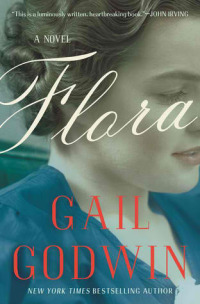Flora by Gail Godwin
 Friday, May 10, 2013 at 8:56PM
Friday, May 10, 2013 at 8:56PM 
Published by Bloomsbury USA on May 7, 2013
A keen observer of life, Gail Godwin is both a student and a teacher of human nature. Her novels tend to be probing studies of characters who struggle with their disconnection from the world around them.
At the age of ten (going on eleven), Helen Anstruther has already developed the most disagreeable characteristics of her mother, who died when she was three, and of her grandmother Honora, who has just died. Helen has inherited their haughty sense of superiority, their tendency to see the worst in others. Her mother's twenty-two-year-old cousin, Flora Waring, is recruited to look after Helen during the summer, when Helen's father (a principal during the school year) will be away supervising construction of buildings that will house the Manhattan Project. Although Flora has earned a teaching degree and is hoping for a job offer in the fall, she is woefully insecure, a trait that Helen feeds upon. Helen regards Flora as white trash from Alabama, a hugely embarrassing addition to her life. At the same time, she is blind to the faults of the father and grandmother who raised her.
Two children in town have contracted polio, causing Helen's father to issue an injunction from afar: Helen is not to leave the house. Although Helen complains, she feels a strong connection to the house, still full of her grandmother's things. The house, once a home to recovering tuberculosis patients (less charitably described as "a halfway house for rich malingerers"), is virtually a character in the novel. Helen's isolation isn't truly troubling. She has little use for friends (as one of them complains, she forgets she has them when they aren't around); she lives largely within her own imaginative mind.
Helen parcels out her time, instructing Flora on the art of being a teacher and, when she can, sneaking a peek at the letters her grandmother wrote to Flora over the years -- letters that reveal family secrets in guarded language that Helen isn't old enough to understand. As Helen makes her way through the summer, she develops a crush on the delivery boy from the grocery store, a young man named Finn whose physical and mental issues earned him a medical discharge from the Army. That he is Flora's age does not deter Helen from viewing Flora as an unworthy competitor for his attention.
Every now and then an older voice intrudes, an adult Helen filled with unfashionable remorse as she looks back on that formative summer. The richness of the characters is astonishing, given the novel's brevity. While we usually see Flora through Helen's unreliable eyes, we see her from a different perspective when we read Honora's letters or hear Finn describing her. While Helen is convinced that she is spending her summer educating Flora, it is actually Flora who teaches the novel's most valuable lessons.
Flora is, in fact, the story of the lessons Helen learned from a teacher she despised: that other people's lives are as worthy as her own; that their tragedies are more real, and more serious, than her own self-invented woes; that risking the pain of opening our hearts to others is essential to a fulfilling life. Godwin tells this dramatic story in radiant but understated prose; even a bombshell in the concluding pages explodes quietly. This is a story that touches feelings without obvious manipulation, a book that fills a reader with joy and sorrow in the same instant and leaves the reader wondering how that's possible.
RECOMMENDED



